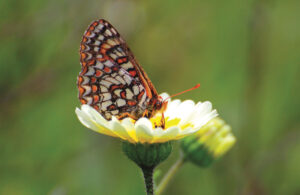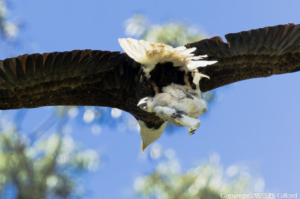At the western edge of the Delta, east of Honker Bay and southwest of the confluence of the Sacramento and San Joaquin rivers, lies a most unexpected gathering of wildlife. Here peregrines hunt from tall towers, beavers lodge unmolested in protected waters, and hummingbirds nest in the least likely of spots. What was once among the busiest, noisiest, smelliest, most crowded, most unsafe places to earn the name “habitat” has become a haven for dozens of species.
In the 1960s the Pittsburg Power Plant was built by Pacific Gas & Electric. On 1,300 acres, it housed a 750-megawatt plant that burned fuel oil to produce electricity. It was bought in 1999 by Mirant, Inc, and today only uses three of its original seven units, and these only during peak demand–summer, when local residences turn on their air-conditioners.
Jon Ridler, the plant’s Senior Control Operator, says this relative calm, along with stiff environmental regulation of emissions, has allowed wildlife to return to the area.
Anna’s hummingbirds are among the staff’s favorites. “They build nests all over the plant, and have for years,” says Ridler. He finds them in the links of chains, in the tops of closed pipes, in any niche available. When a nest was found in the middle of an area workers were overhauling, coordinator Mike McDonald cordoned it off. Workers respect the nest. “Nobody bothers them,” he says. The hummers tolerate great noise and activity around them. Workers built a scaffold right next to them, and the birds were unfazed. Workers watched the 3″ nest, first with the setting mother, then the poking tail feathers of the chicks, then their tiny beaks pointing skyward, waiting for Mom. Soon, they know, the nest will be empty. Oh, well, back to work. (to learn how tell local hummers apart, check out this page from artist Jack Laws.)
The hummingbirds are the favorites, but many other birds nest in the plant. Peregrines nest 160 feet up in the towers on the unused 7 Unit, surveying the river below, and hunting the smaller birds that gather to feast on the insect life. They tolerate human presence also. “Once I was within five feet of a nest,” says Jon, “I didn’t seem to bother them at all.” Workers just reported seeing four eggs in a peregrine nest on the tower. Great horned owls have nested up there, too.
Also in 7 Unit, ravens are building a nest under a grate, open to the river. They sail by as we look on, beaks full of nesting materials. The nest is so far an eclectic mix of sticks, pipe insulation, gasket material, heavy wire, and animal fur.
Down by the river in the tules, three beavers nest a mile apart. No one bothers them. The riverbank is slotted with otter runs and playgrounds. Sea lions are frequently seen eating salmon, “when there are salmon,” says Ridler ruefully. “They haven’t been seen this year.” Coyotes visit frequently, and pond turtles enjoy these balmy waters. (Check out our feature on these turtles, the West Coast’s only native turtle!)
The powerplant has a mile-and-a-quarter cooling canal that loops next to the river. Hot water from the plant cools tumbling over baffles in two open air buildings. That water, when it re-enters the canal, is still warm, creating a spot with lots of invertebrate life, bringing fish, including huge stripers and black bass. The fish, in turn, lure predators. Herons, bittern, and osprey regularly feast here. Other birds are also plentiful: Plenty of ducks come through, and some scoters over-winter. A pair of swans are presently nesting. Ridler says a Canada goose with a broken wing and leg is recuperating somewhere out in the canal. Halfway down a long wooden pier is an impressive chain link fence and locked gate topped with razor-wire. A U.S. Fish and Wildlife Service sign reads “Least Tern Nesting Area.”
During its 2009 Christmas Bird Count, the local Audubon Society chapter identified 67 species on the plant’s grounds.
As I talked with Ridler, I found myself wondering what can be learned from this serendipitous collection of wildlife in a side-lined power plant: Perhaps our environmental laws are working, allowing a once-polluting industry to make a home for wildlife; just maybe if we step aside a bit here and there, we can give animals and plants a chance to repopulate; and last but certainly not least, Anna’s hummingbirds will doggedly rear their young anywhere they like, and maybe they even have a special thing for men in hardhats.

.jpg)




